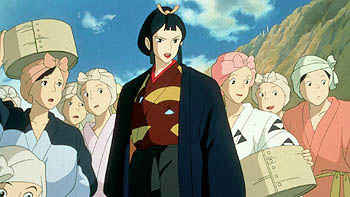![[Metroactive Music]](/music/gifs/music468.gif)
[ Music Index | Silicon Valley | Metroactive Home | Archives ]
 Princess Power: The animated feature 'Princess Mononoke' is part of this weekend's Japantown Vibe event. Cruising J-Town Japantown Vibe festival celebrates area's history and identity By Todd Inoue FOR THE PAST five years, I've helped out at the beef teriyaki booth at the Obon Festival--the two-day Japantown street fair that honors the dead. The day consists of a lot of fun--eating tons of food, catching up with the guys, drinking beer and sake, and cooking stacks of beef skewers. Last year was the first time I participated in the main event--the Obon dance--which, in most un-Buddhist-like terms, invites the spirits to hang out and party. The number of dancers ballooned to 700 with a sizable non-Japanese contingent--black, white, Latino, pan-Asian. Everyone successfully mimicked the stately Japanese ladies in intricate kimonos dancing on the riser. It was a big multicultural smilefest. One got the feeling that Obon Festival--and Japantown--attracted as many gaijin as nihonjin. With Obon dedicated to the spirits and Nikkei Matsuri ushering in spring, Japantown lacks a festival to celebrate itself in the new millennium. Japantown Vibe seeks to change that state of affairs. Giant Creative Services, organizers of Gypsy Cinema and other downtown events, worked alongside the Japantown Business Association to create this new event that seeks to highlight the diversity and identity of J-Town, especially for first-time visitors. Kathy Sakamoto, the association's executive director, gets inspired when she walks down the street, passing the restaurants' doors, and takes in the sights and sounds. "If you go into a Japanese restaurant, half the staff is probably Hispanic," Sakamoto says. "You hear everything from mariachi to salsa to Japanese classical. Hip-hop is on the streets. We wanted to do something contemporary that recognizes and celebrates the history and the area." Japantown Vibe begins Saturday night with an outdoor showing of the family-oriented anime film Princess Mononoke on the Boys and Girls Club lawn. Sunday will be dedicated to an all-day music and culture festival. Martial arts and cooking demos will go down along with performances on two stages by San Jose Taiko, Wesley Jazz Ensemble, One Groove, Felonius, Charanga Nueve and others. J-Town has evolved since the first wave of Japanese immigrants settled in the area in the early 1900s. Before then, Jackson and Taylor streets between Fifth and Sixth streets had been a Chinatown until a fire destroyed it, and the Japanese came in to rebuild and settle alongside the Chinese. It was an agrarian community that housed farmers and field workers. It grew to become a safe, if sleepy, neighborhood with great restaurants. In 2002, the area shows signs of gentrification--peep the Blockbuster--but its touchstones remain. The fresh tofu and manju shops are Bay Area legends. Santo and Dobashi markets stock plenty of Japanese groceries. The Buddhist, Evangelical and Methodist churches compose the area's spiritual center. One of three remaining--and now, thanks to U.S. Senate Bill 307 and Prop. 40, protected--Japantowns in America (the others are in San Francisco and Los Angeles), the area clustered between Taylor Street to the north, Empire Street to the south, between First and 13 streets, has maintained a hometown vitality. What San Jose Japantown lacks in stately museums or huge AMC movie theaters it gains in keeping its neighborhood vibe alive. "We want to show that Japantown is a vibrant part of the community," Sakamoto explains. "It's not just a historic site where everything is preserved. It's an active and vital neighborhood. We've got everything from the neighborhood cat who makes his rounds every morning to Hank Nishijima, who sits outside of his shop [Hank's Rod and Reel] every morning, to Blockbuster Video."
Japantown Vibe--A World of Music and Culture opens Saturday (Aug. 17) with an outdoor screening of 'Princess Mononoke' at 8:30pm at the Boys and Girls Club, 110 Jackson St., San Jose. The Japantown Vibe Music and Street Festival takes place Sunday (Aug. 18), 10am-6pm, at the corner of Fifth and Jackson streets. Log on to www.japantownsanjose.org for details.
Send a letter to the editor about this story via email . [ Silicon Valley | Metroactive Home | Archives ]
|
From the August 15-21, 2002 issue of Metro, Silicon Valley's Weekly Newspaper.
Copyright © Metro Publishing Inc. Metroactive is affiliated with the Boulevards Network.
For more information about the San Jose/Silicon Valley area, visit sanjose.com.